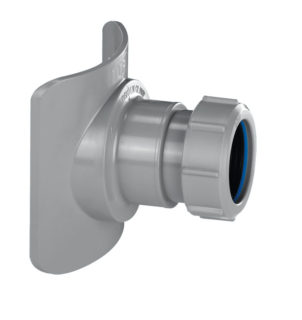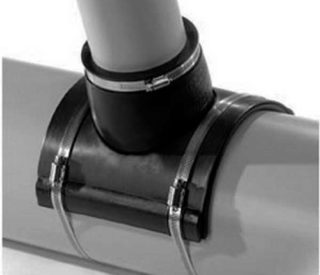Before connecting the pipeline to the existing sewage system, it is important to take into account many nuances - paperwork, system design, choice of materials. When carrying out work on your own, you need to study the technology of connecting to vertical and horizontal risers.
Sewer tie-in

Reasons for an unplanned tie-in of a pipeline into an existing system:
- Connecting household appliances (washing machine) or plumbing equipment. The new site is connected to the local sewerage system.
- Connecting the kitchen.
- Insert of the built house into the system of a microdistrict or village. Pipes lead to a lodge (horizontally located branch) or a riser connecting several houses or apartments.
Since it will not be possible to ensure the absence of wastewater during the work, it is important to use special protective equipment.
Preparatory stage
When choosing accessories for the sewage system, it is necessary to observe the basic rule - the pipeline running household appliances and sinks in a horizontal line must have the most obtuse bending angle. It is important to consider the location of the toilet drain - it can be installed in an inclined position or in a horizontal plane, at an angle of 45 degrees to the floor surface.
When cutting the riser during the day, it is better to first ask the neighbors on top not to use the plumbing equipment for several hours. Required tools and materials:
- Grinder or hacksaw. During the assembly process, these tools are required to cut metal or plastic. When choosing a saw, it is necessary to choose a blade with a fine tooth.
- Crowns. To cut the incoming elements into a pipe with a diameter of 110 mm, a hole of 50 mm is made. Cheap products of the specified size are suitable for plastic. The cast iron riser is processed with a conventional metal drill.
- Wrench.
- Sandpaper or file. When cutting water pipes, remove any burrs left inside the product.
- Sealant.
- Sewer tie-in adapter.
When choosing tools, it is worth considering the material for making pipes.
The main methods of tapping into the sewer pipe

Do-it-yourself insertion into the sewer is possible due to the presence of sealing couplings and adapters. The easiest way is to install a tee. For repairs, you will need to remove a small section of the sewer. A tee is placed in its place, and the connections are insulated. The built-in section must have the same diameter as the pipeline. This method is mainly used for metal systems.
You can crash into a plastic sewer pipe in the following ways:
- With fittings. The riser is first cut, then a thread is made with a tap and fitting connections with branches are installed.
- Using an adapter with a cross section of 5 cm2. It is used for pipes with a diameter of 10-11 cm. When connecting the pipe, it is necessary to free access to the sewage system, determine the distance from the drain to the inset, cut a hole with a crown of the appropriate diameter. The seat is treated with a sealant, then the adapter is installed and the fixing nut is tightened.
You can make a tie-in into a cast-iron sewer pipe if there is a piece of similar communication. Branching features in this way:
- Using a drill with a bimetallic nozzle, drill a hole in the riser.Chips should not remain at the processing site - they can damage the pipeline.
- Clean the hole from metal debris, dirt and grease stains.
- Insert the prepared element into the communication. It is important to be careful - when the adapter is placed deeply, an obstacle for the drains is formed.
- Weld the pipe adapter to the line.
- Treat the seam with an anti-corrosion compound.
The methods of tapping into the sewer differ depending on the location of the riser:
- Vertical. Before connecting household appliances or plumbing fixtures to the PVC pipe, it is necessary to free the pipeline from the fasteners to the walls, cut the pipe section with a grinder to the size of the compensator, clean the edges with a file or sandpaper, put the upper end into a bucket. Then the cut ends of the riser are treated with grease, and the transition sleeve for the tee is put on the lower one. A compensator is put on the upper end and moved until it stops. It remains to lower the expansion joint until it is rigidly fixed in the socket of the tee and fix the riser.
- Horizontal. In this version, a sliding sleeve and an expansion joint with a branch pipe located at an angle of 45 degrees to the pipe are used for connection.
When tapping into a pressure sewer, ordinary adapters for PVC pipes are used. If you need to connect a plastic and cast iron pipeline, use a rubber cuff.
Saddle

You can connect the plumbing to the riser using a saddle - a part of the pipeline designed for the branching device of sewer systems. The element is versatile and can have different diameters. It is made from cast iron, plastic or steel.
The saddle greatly simplifies and reduces the cost of installing the pipeline assembly. When inserting it, the integrity of the sewage system is not violated - it is enough to drill a hole of the required diameter in the pipe. With the help of a saddle, you can connect to the sewage system anywhere. There are several types of such structures:
- Crimp. They are presented in the form of a clamp that clamps the pipe from 2 sides. One of the parts of the product has a threaded outlet that allows you to install transition elements on the cut-in sewer. Crimp saddles are mounted with nuts and bolts. The tightness of the connection is ensured by an O-ring. Such products are used in conjunction with asbestos-cement, polypropylene and polyethylene pipes, PVC models. The maximum media temperature for crimp saddles is 40 degrees.
- Electrowelded with a cutter - designed for HDPE pipes. They are installed using electro-diffusion welding, which implies the presence of a heating coil at the bottom of the attachment piece. Under the influence of a current of a certain power, its temperature rises, and after cooling, the saddle branch with the pipe becomes a single element.
- Branch pipe cover. Such models are divided into 2 types, one of which is equipped with a locking mechanism or a special cutter. The installation of the product can be carried out with the sewerage system running.
When using a saddle, it is easier to tap into the riser, since the part has many varieties.
Inset into the sewer well
For accumulation or filtration of effluents, sewer wells are used, into which all elements of the sewer network are reduced. Features of insertion into such structures:
- A hole is made at the place where the pipe enters the well. Its diameter must exceed the cross-section of the entered communication. Corresponding glands are already provided in plastic products.
- For a differential well and a septic tank, the pipe is cut flush with the inner surface of the tank wall.
- When connecting communications made of cast iron, asbestos cement or ceramics, they must be concreted into the hole.
The pipe should enter the well above the drain level and have a certain slope.
Responsibility for unauthorized insertion

Self-insertion issues are governed by Art. 7.20 of the Code of Administrative Offenses of the Russian Federation "Unauthorized connection to centralized water supply and sewerage systems." The penalty for unauthorized connection to the riser includes the following penalties:
- 1-1.5 thousand rubles - for individuals;
- 2-3 thousand rubles - for legal entities.
A fine is not the biggest expense item for illegal tapping into the sewer. Violators have to pay:
- Services for using the system for a period of 6 months before the date of unauthorized connection detection.
- Dismantling of illegally installed elements.
Since the sewerage device is a complex and costly process, it is better to legally connect to the system right away.
If an illegal connection is found when buying a home, you must immediately report it to the service company. In this case, the new homeowners are not threatened with fines. However, if a box is found during an inspection, sanctions may follow. You can dispute them when you go to court.
You can legalize the existing connection when buying a private house yourself. It is worth first eliminating the installed elements, and then applying for the sidebar. However, this can lead to accidents or conflicts with neighbors. It is worth contacting the communal service, because dismantling may not be necessary if the connection is made in accordance with SNiP.









not destiny to connect with a coupling